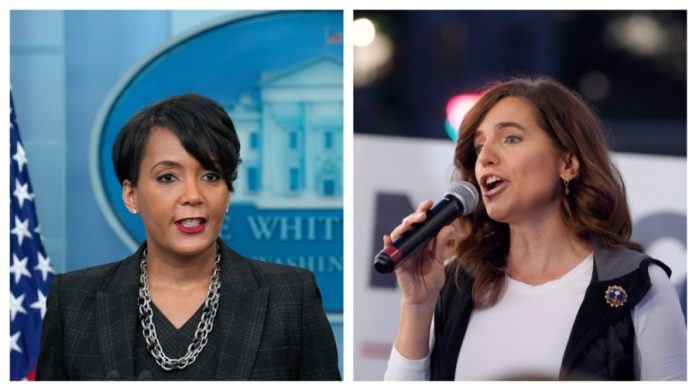
A growing number of Republican and Democratic women are gearing up to run for governor in the 2025 and 2026 elections as more women take the helm of state capitals across the country.
History will be made in Virginia this November as Lt. Gov. Winsome Earle-Sears (R) and former Rep. Abigail Spanberger (D-Va.) vie to be the commonwealth’s first female governor. Meanwhile in New Jersey, Rep. Mikie Sherrill (D-N.J.) is running to become that state’s second female governor.
A number of incumbent female governors, including New York Gov. Kathy Hochul (D) and Arkansas Gov. Sarah Sanders (R), are running for reelection while other candidates including Sen. Marsha Blackburn (R-Tenn.) and former Atlanta Mayor Keisha Lance Bottoms are running to become governor of their respective states for the first time.
“We will absolutely see an additional woman governor in the state of Virginia and a strong possibility of a woman governor in New Jersey, which would make us reach a real record,” said Debbie Walsh, the director of the Center for American Women and Politics (CAWP) at Rutgers University.
For a few weeks in January, 14 women served as governor across the country. That number decreased to 12 in January, when Delaware Gov. Matt Meyer (D) assumed office after the state’s Lt. Gov. Bethany Hall-Long (D) held the position for two weeks following former Gov. John Carney’s (D) resignation to become mayor of Wilmington. In that same month, Homeland Security Secretary Kristi Noem left her post as South Dakota governor ahead of her confirmation process in Washington.
According to CAWP, 40 women, including incumbents, have announced or filed their candidacies for governor ahead of the 2026 cycle.
Blackburn and Bottoms are only a few of the women striving for office after holding legislative and local leadership posts, respectively. In South Carolina, Rep. Nancy Mace (R-S.C.) and Lt. Gov. Pamela Evette (R) are vying for that state’s top executive role in a crowded Republican primary. Michigan Secretary of State Jocelyn Benson (D) and Pennsylvania Treasurer Stacy Garrity (R) are the leading candidates in their parties’ primaries in their respective states.
Meanwhile in New York, Rep. Elise Stefanik (R-N.Y.) is expected to launch a challenge against Hochul after climbing the ranks in Republican leadership circles since she was first elected to the House in 2014. Hochul was lieutenant governor before she replaced former Gov. Andrew Cuomo (D) following his resignation from office. In Arizona, Gov. Katie Hobbs (D), who is seeking reelection next year, served as secretary of state before running for governor.
“This is the evolution of women’s candidacies,” Walsh said. “They have proven records as elected officials and this is that next step for them.”
Walsh noted that it is more common to see men without experience in elected office launch bids for executive office, pointing to New Jersey Gov. Phil Murphy (D).
Prior to his time as governor, Murphy served as U.S. ambassador to Germany under former President Obama and national finance chair of the Democratic National Committee.
“We don’t see that as often for women,” Walsh said. “They kind of have to earn their stripes.”
According to a 2023 Pew Research survey, 54 percent of Americans say a major obstacle for women seeking political office is that they have to do more to prove themselves than men. Forty-seven percent of respondents named women getting less support from party leaders as a major reason.
“When I started at the DGA in 2018, we had more governors named John than we had women governors,” said Meghan Meehan-Draper, executive director at the Democratic Governors Association (DGA).
In 2018, the DGA launched the Women Governors Fund to help recruit and elect Democratic women to gubernatorial office. The group has invested more than $80 million to elect more Democratic female governors over the past seven years.
“There is still more work to be done, and the Women Governors Fund will continue to invest in races to elect more women including Mikie Sherrill and Abigail Spanberger in New Jersey and Virginia this year,” Meehan-Draper said.
One common link between many of the women running in 2025 and 2026 is their backgrounds in national security and law enforcement. Prior to running for governor, Spanberger worked as an intelligence officer for the Central Intelligence Agency, while Earle-Sears served in the Marine Corps. Sherrill is a Navy veteran, previously working as a helicopter pilot. Garrity, who is running in 2026, is a former retired Army Reserve colonel.
“It’s hard to question a candidate’s toughness and strength if she has served in the military, in battle, in combat missions,” Walsh said, adding that serving as state attorney general is also seen as a good “springboard” for gubernatorial candidates. Massachusetts Gov. Maura Healey (D) is an example of one governor who previously served as state attorney general.
Still, there is a large disparity between the number of women who have been governor of a state and men. Only 51 women have served as governor of a U.S. state, while another three have served as the governor of a U.S. territory and two as the mayor of Washington, D.C.
“This kind of goes hand in hand with the challenge we’ve had when it comes to electing a woman president of the United States,” Walsh said. “These chief executive positions still come with a lot of stereotypes about who can lead at that level.”
Walsh argued that many voters perceive women as working best when they are in collaborative settings like in a legislature.
“When voters think about women, they think about them doing well, working collaboratively, working in committees,” Walsh said. “As opposed to being the chief executive. As opposed to being the tough decisionmaker who is the last one in the room who is making that final decision on her own.”

